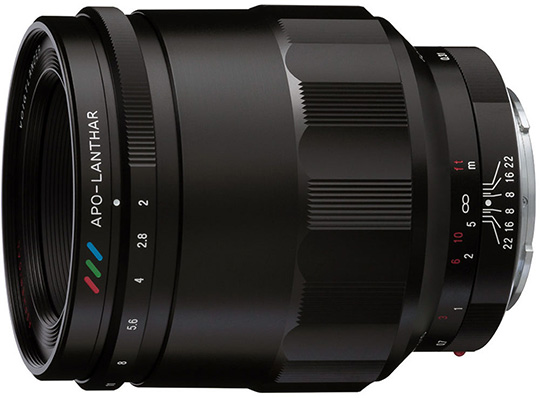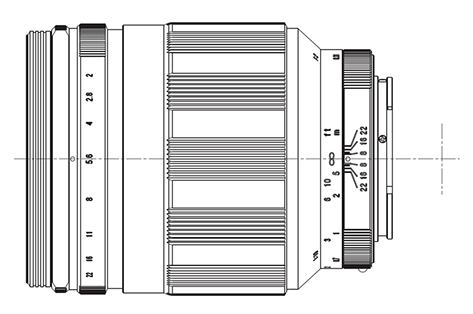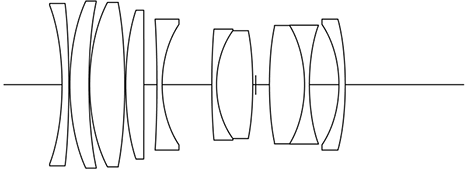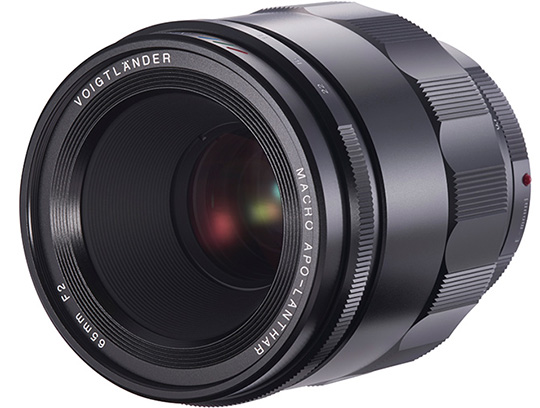


Update: the US price of the lens is $1,059 and is now available for pre-order at B&H and Adorama.
Back in February at the 2017 CP+ show, Cosina announced the development of three new full frame Voigtlander lenses for Sony E-mount. The new lenses will have:
- EXIF transmission to camera body
- Support for five-axis image stabilization
- Manual focus
- 1/3 step aperture selection
One of the lenses, the Voigtlander APO-MACRO LANTHAR 65mm f/2 Aspherical E-mount lens is now officially released - shipping will start on August 10th in Japan.
The European price is 999 Euros. The US price is not officially released yet (check here for updates).
Some sample photos from the lens can be found here, here and here. The technical specifications of the lens:
| Focal length used on full format camera body | 65 mm |
| Aperture ratio | 1:2 |
| Minimum aperture | F22 |
| Click-stop | tba |
| Lens construction | 10 elments in 8 groups |
| Angle of view | 38° |
| Aperture blade | 10 |
| Minimum focus | 0,31 m |
| Maximum diameter | 77,2 m |
| Length | 98,5 mm |
| Mount | E |
| Electrical contact: Exif data transfer from lens to camera body for lens correction | available |
| Manual focus assistant | available |
| Weight | tba |
| Filter size | 67 mm |
| Color | black |
| Others | Selective aperture control system, "screw-in"-type lens hood |
| Optional | --- |

Additional info on the Voigtlander APO-Macro Lanthar 65mm f/2 Aspherical E-mount lens:
The Voigtländer MACRO APO-LANTHAR 65mm F2 Aspherical was announced at Photokina 2016 in Cologne, Germany, as a reference exhibit. Since then specifications and appearance have been improved. The Red, Green, and Blue lines on the lens barrel proudly indicate its heritage from vintage APO-LANTHAR lens designs - High Performance. At F2, this lens is one of the fastest macro lenses available for full frame format. Macro Ratio is 1:2. Minimum Object Distance is 31cm.
Here are two hands-on videos of the lens from the 2017 CP+ show:
Update - here is the full press release:
Announcing the release of the Voigtländer MACRO APO- LANTHAR 65mm F2 Aspherical, a Sony E-mount macro lens for full frame sensors incorporating an apochromatic optical design and inscribed with the designation “APO-LANTHAR”
We announce the release of the Voigtländer MACRO APO-LANTHAR 65mm F2 Aspherical, a Sony E-mount macro lens for full frame sensors. The APO-LANTHAR designation is given to especially high performance lenses in the Voigtländer lens lineup. The legendary APO-LANTHAR lens that continues to enthrall photographers with its outstanding imaging performace and beautiful rendering was born in 1954, but its origins can be traced back around 120 years (see additional info about the APO-LANTHAR below).
A need for apochromatic optical designs that reduce the longitudinal chromatic aberrations of the three primary colors (RGB) of light to practically zero arose with the increasing popularity of color film. Now, with the current range of high- resolution digitals sensors, this need for extremely high-level control of chromatic aberrations is even more pertinent than when film changed from monochrome to color. So rather than just being for already solved old technologies, apochromatic optical designs are indeed a subject requiring serious consideration in the digital age.
The Voigtländer MACRO APO-LANTHAR 65mm F2 Aspherical, which inherits the designation “APO- LANTHAR”, is a high performance manual focus macro lens optimized for the imaging sensors of Sony mirrorless cameras. The optical performance of this lens, which provides an image circle capable of covering a full frame sensor, rates as one of the finest in the history of Voigtländer. Sharp imaging performance is obtained from maximum aperture where you can enjoy blurring the background, and by utilizing a floating mechanism this lens delivers outstanding image quality for subjects from the minimum focusing distance of 31cm (reproduction ratio of 1:2) through to infinity. This lens is a manual focus and manual aperture design, but also features electrical contacts that enable the lens settings at image capture to be included in the Exif information of the image data. Furthermore, the lens is installed with a distance encoder to enable support for 5-axis image stabilization on bodies with this feature, for example by providing distance to subject information used in X,Y shift compensation. Focus peaking while manual focusing is also supported.
Main features
- Full frame Sony E-mount with electrical contacts
- Apochromatic optical design that eliminates chromatic aberrations
- Enhanced high performance utilizing aspherical lens surfaces
- Optical design optimized for digital imaging sensors
- Extremely solid and durable all-metal barrel
- Manual focus for precise focusing
- Maximum reproduction ratio of 1:2 at a minimum focus distance of 31 cm
Additional info about the APO-LANTHAR
The history of the APO-LANTHAR begins with the HELIAR invented by Hans Harting in 1900. Despite its simple optical configuration of five elements in three groups, the HELIAR was a lens with superb depictive performance. As an example of the HELIAR optical formula still being valid in the present day, it is used in the currently available HELIAR Vintage Line 50mm F3.5, a lens known for its superb depictive performance. Furthermore, a HELIAR is recorded as being the lens used to take imperial portraits of Emperor Showa, and it is said the HELIAR lens was extremely highly regarded for its beautiful depictive performance and even treated as a family treasure by portrait photography businesses during the Showa period.
Moving forward about half a century from the birth of the HELIAR to 1954, Albrecht Wilhelm Tronnier developed a lens using the same five-elements-three-groups configuration as the HELIAR utilizing new glass types to achieve performance that exceeded the HELIAR. That lens was the APO-LANTHAR. The APO in APO- LANTHAR indicates an apochromatic optical design. The main characteristic of such a lens is that longitudinal chromatic aberrations caused by the different wavelengths (frequencies) of the three primary colors (RGB) of light are reduced to practically zero to achieve high-level color reproduction. Color film slowly gained popularity after its release in 1935, and one reason why the APO-LANTHAR was developed was to address a growing need to capture light more faithfully than possible with monochrome film.
The first camera to be fitted with an APO-LANTHAR lens was the 6 x 9 roll film rangefinder camera representative of post-war Voigtlander, the Bessa II. There were three different lens variations of this camera: APO-LANTHAR 4.5/100, COLOR-HELIAR 3.5/105, and COLOR-SKOPAR 3.5/105. The APO-LANTHAR 4.5/100 variation has red, green, and blue (RGB) rings indicating the apochromatic optical design engraved around the front of the lens barrel to differentiate it from the other versions as a special lens. Due to the rarity and high performance of the Bessa II fitted with APO-LANTHAR lens, this camera has become a legendary camera traded on the used market at high prices and the envy of camera collectors.
As homage to the RGB colors that differentiate the APO-LANTHAR from other lenses beginning with the BESSA II, the MACRO APO-LANTHAR 65mm F2 Aspherical also features three colored dashes indicating the RGB colors at the front edge of the lens barrel.








